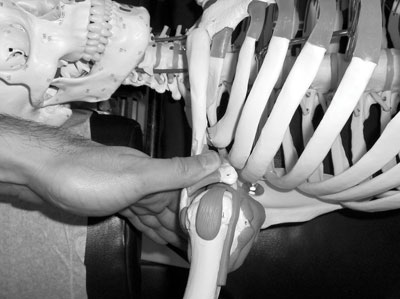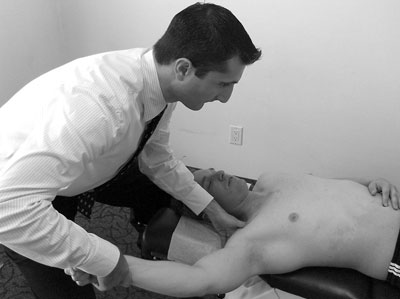
A 40-year-old male office worker presented to the clinic with shoulder injury following a recreational softball game.
SAMPLE CASE
A 40-year-old male office worker presented to the clinic with shoulder injury following a recreational softball game. The patient informs the doctor that, last week, he collided into an opposing player’s leg as he tried to slide into second base. The patient states that, following the collision, he felt immediate discomfort and experienced a decreased range of motion in the affected arm. The patient can also pinpoint his discomfort over the acromioclavicular joint.
 |
|
| Photo 1: The contacts for a distal clavicle superior subluxation are displayed on the skeletal model Advertisement
|
Observation of the shoulder shows swelling in the anterior compartment – however, no Horizon Sign is present. Physical examination reveals palpatory subluxations at C5 on the right, and the S1 on the left. Further examination of the affected shoulder reveals palpatory tenderness on the anterior and superior aspects of the shoulder. Abduction is limited to 120 degrees, and reproduces the patient’s discomfort. Remaining shoulder ranges of motion are normal. All neurological and X-ray analysis is unremarkable.
Has this type of patient ever walked into your clinic? Are you comfortable assessing and correcting problems with the acromioclavicular (AC) joint? In this edition of Technique Toolbox, we will discuss assessment of the AC joint and proper adjustment of a distal clavicle subluxation.
Before beginning to assess the shoulder, the doctor must initially ensure that all primary, secondary and tertiary subluxations of the spine have been assessed and corrected. One must always be mindful that a properly functioning spine and nervous system is essential before any extremity adjusting takes place.
To accurately detect and correct a subluxation of the distal clavicle within the acromioclavicular joint, the doctor will look for the following:
STEP ONE: ASSESSMENT
- Patient presents with anterior shoulder pain, which is aggravated at 120 degrees of arm abduction.
- Doctor’s observation will detect a Horizon Sign present at the distal aspect of the clavicle. A Horizon Sign is quite simply a lump that is produced when the acromioclavicular joint is damaged, resulting in the clavicle lifting away from the acromion process, producing the protuberance.
STEP TWO: X-RAY
Because of the physical collision that caused this injury, an X-ray must be taken. If no signs of fracture or instability exist, the doctor must distinguish which Grade of AC strain is present:
- Grade 1: Patient has no Horizon Sign present, indicating that the majority of the supporting structures are stable and firmly attached.
- Grade 2: Patient has a Horizon Sign present; however, some supporting structures are still attached.
- Grade 3: Patient has a Horizon Sign present; however, the vast majority of supporting structures are unattached.
Step Three: MUSCLE TEST
In order to help the doctor clinically differentiate which Grade of AC strain exists, the doctor will perform a coracobrachialis muscle test:
- Patient: Supine. Shoulders flexed 30 degrees. Elbows flexed to 90 degrees.
- Doctor: Head of table.
- Procedure: Doctor places palms on the patient’s biceps and applies caudad pressure. The patient is instructed to resist the doctor’s caudad pressure.
- Normal: If no AC strain or clavicular subluxation existed, this muscle test would be performed pain-free, and the muscle test would result in the distal clavicle moving slightly inferior.
However, when a subluxation of the distal clavicle is present, subsequently causing an AC strain, the muscle test produces the following signs:
- Grade 1: Muscle test produces pain at the AC joint; however, patient is able to apply a significant amount of resistance to the caudal pressure. Horizon Sign continues not to be present, and the distal clavicle moves slightly inferior during muscle testing.
- Grade 2: Muscle test produces significant pain at the AC joint, and the patient can apply limited resistance to the caudal pressure. Horizon Sign continues to be present; however, distal clavicle moves slightly inferior during muscle testing.
- Grade 3: Muscle test does not produce significant pain; however, the patient cannot provide resistance to the caudal pressure. Horizon Sign persists, and the distal clavicle remains superior during muscle testing.
 |
|
| Photo 2: The contacts for a distal clavicle superior subluxation are displayed on the patient. Note how the affected side arm is abducted to 120 degrees. |
The doctor will be able to treat a Grade 1 or Grade 2 AC strain, but not a Grade 3. Therefore, this muscle testing to determine the grade of AC strain is necessary. If a patient demonstrates signs associated with a Grade 3 AC strain, he or she must be referred elsewhere, as it would be a direct contraindication for adjustment.
A distal clavicle subluxation affecting the AC joint indicates that the distal clavicle has subluxated superior.
STEP FOUR: CORRECTION
AC Adjustment (See Photos 1 and 2)
- Patient: Supine.
- Doctor: On affected side. Head of table. Facing caudad.
- Table: Dorsal piece is in the ready position.
- Contact: Web contact on the superior aspect of the distal clavicle.
- Stabilize: Abducting involved arm to 120 degrees.
- LOC: SI, AP.
This adjustment can be uncomfortable for the patient but is extremely effective as the superior clavicle is decreased immediately. Due to the potential discomfort, it is recommended that the affected area be iced quickly after to help avoid or minimize any pain or swelling.
As usual, I have only scratched the surface with potential shoulder injuries. One must be mindful that the shoulder has seven articulating structures, and therefore, several factors must be differentially diagnosed before moving on to one adjustment or another. Once the AC joint is involved, and the distal clavicle subluxated, this adjustment will provide tremendous assistance to the patient.
If you have any questions or concerns, please e-mail me at johnminardi@hotmail.com.
Until next time . . . adjust with confidence!
Dr. John Minardi is a 2001 graduate of Canadian Memorial Chiropractic
College. A Thompson-certified practitioner and instructor, he is the
creator of the Thompson Technique Seminar Series and author of The
Complete Thompson Textbook – Minardi Integrated Systems. In addition to
his busy lecture schedule, Dr. Minardi operates a successful private
practice in Oakville, Ontario. E-mail johnminardi@hotmail.com, or visit www.ThompsonChiropracticTechnique.com .
Print this page